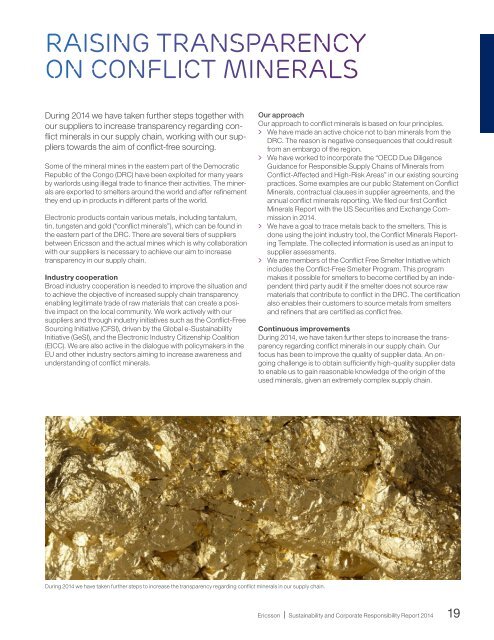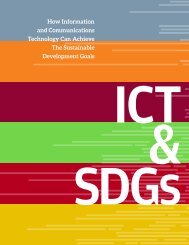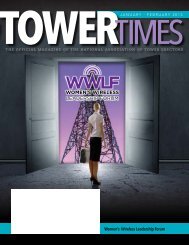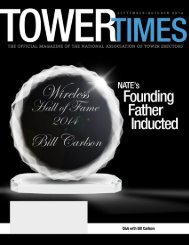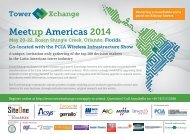Ou7h5
Ou7h5
Ou7h5
You also want an ePaper? Increase the reach of your titles
YUMPU automatically turns print PDFs into web optimized ePapers that Google loves.
aising transparencyon conflict mineralsDuring 2014 we have taken further steps together withour suppliers to increase transparency regarding conflictminerals in our supply chain, working with our supplierstowards the aim of conflict-free sourcing.Some of the mineral mines in the eastern part of the DemocraticRepublic of the Congo (DRC) have been exploited for many yearsby warlords using illegal trade to finance their activities. The mineralsare exported to smelters around the world and after refinementthey end up in products in different parts of the world.Electronic products contain various metals, including tantalum,tin, tungsten and gold (“conflict minerals”), which can be found inthe eastern part of the DRC. There are several tiers of suppliersbetween Ericsson and the actual mines which is why collaborationwith our suppliers is necessary to achieve our aim to increasetransparency in our supply chain.Industry cooperationBroad industry cooperation is needed to improve the situation andto achieve the objective of increased supply chain transparencyenabling legitimate trade of raw materials that can create a positiveimpact on the local community. We work actively with oursuppliers and through industry initiatives such as the Conflict-FreeSourcing Initiative (CFSI), driven by the Global e-SustainabilityInitiative (GeSI), and the Electronic Industry Citizenship Coalition(EICC). We are also active in the dialogue with policymakers in theEU and other industry sectors aiming to increase awareness andunderstanding of conflict minerals.Our approachOur approach to conflict minerals is based on four principles.> > We have made an active choice not to ban minerals from theDRC. The reason is negative consequences that could resultfrom an embargo of the region.> > We have worked to incorporate the “OECD Due DiligenceGuidance for Responsible Supply Chains of Minerals fromConflict- Affected and High-Risk Areas” in our existing sourcingpractices. Some examples are our public Statement on ConflictMinerals, contractual clauses in supplier agreements, and theannual conflict minerals reporting. We filed our first ConflictMinerals Report with the US Securities and Exchange Commissionin 2014.> > We have a goal to trace metals back to the smelters. This isdone using the joint industry tool, the Conflict Minerals ReportingTemplate. The collected information is used as an input tosupplier assessments.> > We are members of the Conflict Free Smelter Initiative whichincludes the Conflict-Free Smelter Program. This programmakes it possible for smelters to become certified by an independentthird party audit if the smelter does not source rawmaterials that contribute to conflict in the DRC. The certificationalso enables their customers to source metals from smeltersand refiners that are certified as conflict free.Continuous improvementsDuring 2014, we have taken further steps to increase the transparencyregarding conflict minerals in our supply chain. Ourfocus has been to improve the quality of supplier data. An ongoingchallenge is to obtain sufficiently high-quality supplier datato enable us to gain reasonable knowledge of the origin of theused minerals, given an extremely complex supply chain.During 2014 we have taken further steps to increase the transparency regarding conflict minerals in our supply chain.Ericsson | Sustainability and Corporate Responsibility Report 201419


